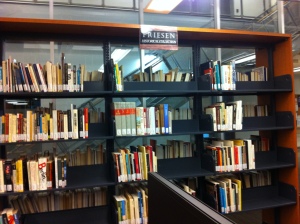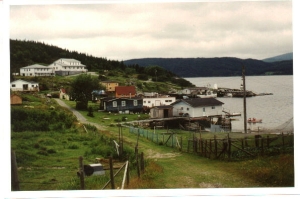

Thompson has been through tough times before. Pick a year: 1971 or 1977 or 1981 or 1999 perhaps. Take 1981 for instance. A “Hard Times” dance for striking Inco Steelworkers on Oct. 24, 1981 was packed to capacity. The Thompson Chamber of Commerce was in full panic mode as local merchants, along with striking miners, faced the prospect of a very bleak Christmas 1981. Numerous homes and businesses were boarded up. A dissident USW group was demanding a vote on Inco’s most recent offer (they got it and it was turned down). Nickel prices continued to slide, selling for just over $3 per pound, while worldwide demand had sagged 12 per cent below 1974 levels. The company was reporting a record third quarter loss of $US 29.4 million – its worst performance in 50 years. Canada and the rest of the world were sliding into a brutal recession. And so on.
Legends have made been made out of how resilient Northerners are and how Thompsonites persevered through the bad times until sunnier days dawned again. But that’s because a downturn in mining was always followed by an upswing, sooner or later. Boom-and-bust. Mining is a cyclical boom-and-bust business involving a finite resource, in this case nickel, which is eventually depleted. Thompson’s first mining bust came in 1971, scarcely a decade after the town was born, when Inco announced the closing of the Soab mines; Pipe Number 1 Mine was closed; and work was slowed down at the open pit as all production was cut and more than 200 jobs shed. By the end of 1971, Inco had laid off 30 per cent of its workforce here. “The Greens” on Nickel Road, part of the eight-building apartment complex made up also of “The Pinks” and “The Yellows,” as old-timers still sometimes call them, built by Malcolm Construction in the 1960s, wound up back in the hands of mortgagor Canada Mortgage and Housing Corporation (CMHC) and sat vacant for more than two years. Things improved in the mid-1970s but got tough again in both 1977 – with major job cuts at Inco – and again in 1981 with a bitter strike. But the good times always returned again to follow the bad. Just be patient and wait.
What if none of that is true this time? Does anyone seriously believe Vale’s Birchtree Mine, with about a couple of hundred jobs, is going to be open many years after the closure of the smelter and refinery next year and the 500 Vale jobs, give or take, about to disappear there one way or the other, as well as those of 250 to 375 contractors employed by the company. The mine was previously on “care and maintenance” from 1977 to 1989.
What if there’s no bounce-back in mining?
While Vale’s $100-million-plus concentrate load-out facility and Dam B tailings expansion is welcome news looking toward the future of Vale’s Manitoba mining and milling operations here in Thompson, what if Vale’s proposed Thompson Foot Wall Deep Project, at the north end of Thompson Mine, previously known as Thompson (1D), with its 11 million tonnes of nickel mineralization, which forms a deep, north-plunging continuation of the Thompson deposit, doesn’t go ahead to help sustain the Thompson operation, given nickel is selling on the London Metal Exchange (LME) for US$4.96/lb. The refinery and smelter, which both opened March 25, 1961, are set to close next year and about 30 per cent of Vale’s production employees in Thompson work in the smelter and refinery.
Here’s a hint. Tourism, wolf or any other kind, is not going to save Thompson, if the goal is to maintain the city even at its current level of reduced economic vitality, much less return it to the glory nickel mining days of the 1960s. While hosting the 2018 Manitoba Winter Games next year will bring about 1,400 athletes and about 3,000 people overall – including coaches, officials and fans – into the city over an eight-day span, it is no long-term panacea for Thompson’s coming economic woes. Instead, it should hopefully be a nice one-time economic booster shot at a very welcome time.
Manitoba Chambers of Commerce president and CEO Chuck Davidson, who grew up in Northern Manitoba in both Flin Flon and Snow Lake, where he graduated high school, along with Opaskwayak Cree Nation Onekanew Chief Christian Sinclair, who co-chair the province’s Look North Task Force, which rolled out its new “Look North” website at http://www.looknorthmb.ca recently, both know that over the next two to three years about 1,000 jobs are going to disappear throughout Northern Manitoba, with a direct a loss of close to $100 million in annual income – and if you add-on a standard multiplier effect of three – an indirect loss of about $300 million is just around the corner. Try triaging that with tourism.
I’m a local ratepayer and I work in both the private and public sectors in Thompson. I’ve lived here for a few months short of a decade. In the private sector, I work in the hotel industry, so I have a personal interest in seeing the tourism industry doing well in Thompson, and I do what I can for my part to facilitate that. I also work in the post-secondary institutional public sector here as a public servant, so again, I very much want to see the people I serve every day do well. And while I think there are some good folks involved with both the Manitoba Chambers of Commerce provincially and the Thompson Chamber of Commerce locally, I’ve been around here long enough to remember ideas such as Barry Prentice’s airships to the arctic, which proposed using enormous cigar-shaped balloons, up to six storeys high, touted to offer cheap, reliable transportation for people and cargo, or Ernesto Sirolli, of Sacramento, California speaking to the local chamber, as the Italian-born founder of community economic development “enterprise facilitation.”
Sirolli developed the concept of enterprise facilitation more than three decades ago in Esperance, a small rural coastal community in Western Australia and now heads the Sirolli Institute in Sacramento. Esperance, an isolated coastal town of 8,500, had 500 people registered as unemployed in 1985, and a recent quota on fishing tuna that shrunk the local fishing industry.”Want to help someone? Shut up and listen!” Sirolli has famously said many times. “In 1975 I read Small is Beautiful by Ernest Schumacher. He was an economist who was critical of the Western approach to development in the Third World and he proposed a different approach known as ‘intermediate technology.’
“I was intrigued by his approach but what truly inspired me was something he wrote: ‘If people do not wish to be helped, leave them alone. This should be the first principle of aid,'” Sirolli said.
Tourism is often touted by politicians of various stripes as a fix-it for winding-down resource-based economies. But it just isn’t so. Tourism has some complementary economic role to play, more in Churchill than Thompson, but it will never replace high-value private sector mining jobs, such as exist at Vale’s above ground surface smelter and refinery operations, and underground at Birchtree Mine. Why is it so hard to say so out loud?
Same goes for the Thompson Economic Diversification Working Group (TEDWG), which was created in May 2011, six months after Vale announced the shutdown of the refinery and smelter in November 2010, and which has been lauded by what passes for thought leaders in Thompson as an example of how resource-based companies and the communities they operate in can work together to address the ramifications of changes in operations. “Unfortunately,” the Thompson Citizen rightly noted in a Feb. 8 editorial, “processes don’t mean much unless they achieve some tangible results and it’s difficult to see exactly what the time (and money, in Vale’s case) dedicated to the process has yielded so far.”
Vale paid out more than $2.5 million in cash to fund TEDWG, mainly using Toronto-based consultants rePlan, a Canadian firm with decades of experience helping resource-based companies and communities adapt to change. Within its first year, TEDWG had identified by the end of 2012 – more than four years ago now – five keys area of focus: a restorative justice facility, education and training, local and regional identity, housing, and economic development. Sirolli’s visit here in September 2013 came as local businesses stood at a crossroads as the implementation work coming out of TEDWG was supposed to begin. Ask yourself where we are today with that agenda?
Prentice and Sirolli may well be visionaries, but well-meaning chambers of commerce folks? Not so much, I’m afraid.
Ask yourself about TEDWG right after you ponder for a few minutes whatever happened to the Thompson Community Development Corporation, better known as Thompson Unlimited, the city’s economic development corporation established in 2003 and disbanded last June by city council to be replaced by what? A City Hall operation to showcase Thompson’s rising taxes and water bills, along with falling housing prices and businesses closing?
Northern Manitoba needs much more than tourism. Lonely Planet, the world famous and largest travel guide on the planet, started by Tony and Maureen Wheeler more than 40 years ago, published an entry back in mid-2015 simply called “Introducing Thompson,” which can be found at: https://www.lonelyplanet.com/canada/thompson, and the result isn’t pretty. “Carved out of the boreal forest by mining interests in the 1950s, Thompson is a rather charmless town that travelers pass through en route to Churchill.”
True, two exceptions are named: “Thompson’s relatively new fame as ‘Wolf Capital of the World’ and a Boreal Discovery Centre that allows visitors to learn all about this predator, common in the wilderness around town, as well as other denizens of the boreal.” Well, the Thompson Zoo, which had opened in 1971, closed its doors going on five years ago now in the fall of 2012 and the resident animals decamped elsewhere. The future Boreal Discovery Centre on the site is, well, future. Lonely Planet is famous in its own words for telling travelers what a place is like “without fear or favor … we never compromise our opinions for commercial gain.”
Think of it this way. How many of us who now live in Thompson came to the city initially because we were drawn here by tourism of any kind? That’s what I thought. We came for a job and stayed for the job or jobs. Paint Lake, Pisew Falls and Sasagiu Rapids are nature’s bonuses, not the original draw here.
Along with Fodor’s and Frommer’s, Lonely Planet is one of the more respected and widely quoted travel guides in the world in what is a fairly crowded field.
Even Churchill, with its well established polar bear tourism, along with growing beluga whale and other eco-tourism, will be dead in the water if the Port of Churchill doesn’t get back to shipping something soon, and freight rail service is increased again. OmniTRAX, the Denver-based short line railroad, which owns the Port of Churchill, announced last July 25 it would be laying off or not re-hiring about 90 port workers, as it was cancelling the 2016 grain shipping season. At the time the cancellation was announced near the end of July, OmniTRAX did not have a single committed grain shipping contract. Normally, the Port of Churchill has a 14-week shipping season from July 15 to Oct. 31.
OmniTRAX bought most of Northern Manitoba’s rail track from The Pas to Churchill in 1997 from CN for $11 million. The track reached Churchill on March 29, 1929. The last spike, wrapped in tinfoil ripped from a packet of tobacco, was hammered in to mark completion of the project: an iron spike in silver ceremonial trappings. OmniTRAX took over the related Port of Churchill, which opened in 1929, when it acquired it from Canada Ports Corporation, for a token $10 soon after buying the rail line. The Port of Churchill has the largest fuel terminal in the Arctic and is North America’s only deep water Arctic seaport that offers a gateway between North America and Mexico, South America, Europe and the Middle East. OmniTRAX created Hudson Bay Railway in 1997, the same year it took over operation of the Port of Churchill. It operates 820 kilometres of track in Manitoba between The Pas and Churchill.
OmniTRAX had a terrible grain shipping season through Canada’s most northerly grain and oilseeds export terminal in 2015, moving only 184,600 tonnes as compared to 540,000 tonnes in 2014 and 640,000 tonnes in 2013. In 1977 an all-time record 816,000 tonnes were shipped from the Port of Churchill. OmniTRAX is on a Canadian National (CN) interchange at The Pas and relies on CN for the grain-filled cars. OmniTRAX considered 500,000 tonnes a normal shipping season. Wheat accounts for most of the grain loaded in Churchill, with some durum and canola also being shipped. In addition to grain and oil seeds, the shipping season has also included vessels loaded with re-supply shipments, such as petroleum products, northbound for Nunavut.
OmniTRAX moved between 2011 and 2014 to diversify the commodity mix the railway and port handle here in Manitoba in the wake of the federal government legislating the end of the Canadian Wheat Board’s grain monopoly, creating a new grain market. OmniTRAX said at the time transporting just grain would not be enough to sustain their Manitoba business over the longer term. The Canadian Wheat Board, renamed G3 Canada Ltd. by its new owners, has built a network of grain elevators, terminals and vessels that bypasses Churchill and uses the Great Lakes, St. Lawrence River and West Coast to move grain to foreign markets.
In 2013, worried about the viability of relying primarily on grain shipments through Churchill, OmniTRAX unveiled plans to ship Bakken and Western Intermediate sweet crude oil bound for markets in eastern North America and Western Europe on 80-tanker car Hudson Bay Railway trains from The Pas to Churchill and then from the Port of Churchill on Panamax-class tanker ships out Hudson Bay, the world’s largest seasonally ice-covered inland sea, stretching 1,500 kilometres at its widest extent, to markets in eastern North America and Western Europe.
However, the oil-by-rail to Churchill plan, unveiled in Thompson on Aug, 15, 2013, met a firestorm of public opposition, ranging from local citizens, members of First Nations aboriginal communities along the Bayline between Gillam and Churchill, with whistle stops in places like Bird, Sundance Amery, Charlebois, Weir River, Lawledge, Thibaudeau, Silcox, Herchmer, Kellett, O’Day, Back, McClintock, Cromarty, Belcher, Chesnaye, Lamprey, Bylot, Digges, Tidal and Fort Churchill, environmental activists, including the Wilderness Committee’s Manitoba Field Office, and even government officials – opposition fueled in part no doubt by the tragedy only 5½ weeks earlier at Lac-Mégantic, Québec where a runaway Montreal, Maine & Atlantic Railway (MMA) freight train carrying crude oil from the Bakken shale gas formation in North Dakota – in 72 CTC-111A tanker cars – derailed in downtown Lac-Mégantic in Quebec’s Eastern Townships on July 6, 2013. Forty-seven people died as a result of the fiery explosion that followed the derailment.
Within a year, OmniTRAX shelved its oil-by-rail shipping plan from The Pas to Churchill in August 2014.
After more than a year of due diligence, OmniTRAX and the Mathias Colomb First Nation, Tataskweyak Cree Nation and the War Lake First Nation, known as the Missinippi Rail Consortium, signed a memorandum of understanding last December for the latter to buy OmniTRAX’s rail assets in Manitoba, along with the Port of Churchill, but the deal has not been completed to date, as the consortium looks for additional investors, and neither the provincial or federal governments are rushing for a seat at that table. Whatever other investors may be out there and how deep their pockets are remain to be seen. Just four days before the provincial election last April 19, OmniTRAX Canada filed a lawsuit on April 15, 2016 against the province, along with former NDP Premier Greg Selinger and former Thompson MLA and minister of infrastructure and transportation Steve Ashton, naming them as individual defendants, alleging they interfered in December 2015 in the sale of Hudson Bay Railway, a wholly-owned subsidiary of OmniTRAX Canada, to a consortium of 10 Northern Manitoba First Nations, led by Mathias Colomb Cree Nation, by disclosing confidential financial information about OmniTRAX Canada to consulting firm MNP LLP and Opaskwayak Cree Nation (OCN) at The Pas. That lawsuit remains outstanding.
As for the University College of the North (UCN), Northern Regional Health Authority (NRHA) and other provincial government departments and agencies in Northern Manitoba, they are are not going to offer economic salvation either.
While the public sector has some very good and well paid jobs and will continue to, the overall trend over the next several years is going to be away from growth and moving in the opposite direction toward job and budget cuts. The Pallister Tories have already told Helga Bryant’s NRHA to find about $6 million in savings in its $230-plus million annual budget. The province last month also announced it was scrapping for now at least a $9 million planned renovation of the Northern Consultation Clinic here in the basement of Thompson General Hospital. The clinic itself, which houses among other things, a number of resident and visiting medical specialties, who come through town on a rotating basis, sort of like a locum, remains open to see patients, often referred by a general or family practitioner.
“Barring a miracle, things in Thompson and in the north as a whole are not going to get better economically in the short term and it looks quite likely that they will actually get worse,” the Thompson Citizen observed editorially March 1. “What’s more, no white knight is going to ride in in the form of a company looking to employ lots of people in high-paying jobs that begin right away and last until the end of time.”
Every spring for the last 12 years, Toronto-based MoneySense magazine has published a closely watched annual survey, which ranks cities across the country from best to worst places to live in Canada – both overall and in specific categories. In the most recent survey, published last June in the summer issue of the magazine, Thompson got a nice bounce back up to 132nd spot in 2016 after its worst worst-ever finish in 177th place in 2015.
This year? Time will tell soon enough.
Same for Statistics Canada’s annual Juristat Crime Severity Index values, which will be released in July, for police services policing communities over 10,000 in population, with their Violent Crime Severity Index, Overall Crime Severity Index and Non-Violent Crime Severity Index values.
The crime severity indexes are calculated by assigning crimes different weights based on seriousness as measured by each crime’s incarceration rate and the average prison sentence courts mete out for each crime. The weighted offences are then added up and divided by population. The CSI is standardized to a base of 100 which is derived from the index values for the year 2006. While some of Thompson’s perennially high index numbers have improved marginally in recent years, the Violent Crime Severity Index did not, as we went from being fourth-highest in that category to third highest last year, behind North Battleford and Prince Albert in Northern Saskatchewan.
You can also follow me on Twitter at: https://twitter.com/jwbarker22
55.743021
-97.844506
 Thompson, Manitoba has again topped Statistics Canada’s annual Violent Crime Severity Index (CSI) for police services policing about 300 communities over 10,000 in population. This year’s report was issued July 27, with statistics from 2022.
Thompson, Manitoba has again topped Statistics Canada’s annual Violent Crime Severity Index (CSI) for police services policing about 300 communities over 10,000 in population. This year’s report was issued July 27, with statistics from 2022.









